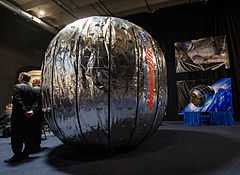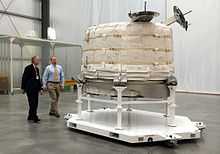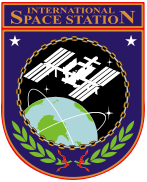Bigelow Expandable Activity Module
 Full-scale mock-up of BEAM, January 16, 2013 | |
| Station statistics | |
|---|---|
| Launch date: | September 2, 2015 |
| Launch vehicle: | Falcon 9 v1.1 |
| Mass: | 3,000 lb (1,360 kg)[1] |
| Length: | 13 ft (4 m)[1] |
| Diameter: | 10.5 ft (3.2 m)[1] |
| Living volume: | 565 cu ft (16 m3)[2] |
The Bigelow Expandable Activity Module (BEAM) is an expandable space station module being developed by Bigelow Aerospace, under contract to NASA, for use as a temporary module on the International Space Station (ISS) during 2015 to 2017. Bigelow has plans to build a second BEAM module as an airlock for the Bigelow Commercial Space Station.
History
With NASA taking a second look at expandable module technology beginning in early 2010,[3][4] various options were considered, including Bigelow for providing what at the time was to have been a torus-shaped storage module, called the Bigelow Expandable Activity Module, for the ISS. One application of the toroidal BEAM design was as a centrifuge demo preceding further developments of the NASA Nautilus-X multi-mission exploration vehicle.[5] In January 2011, Bigelow projected that this module could be built and made flight ready 24 months after a build contract was secured.[6]
On December 20, 2012, NASA awarded Bigelow Aerospace a US$17.8 million contract to construct the Bigelow Expandable Activity Module,[7] under NASA's Advanced Exploration Systems (AES) Program.[8]
NASA plans made public in mid-2013 called for a 2015 delivery of the module to the ISS,[9] and as of January 2015, the date appears to be holding.[10]
Two flight units planned
ISS flight unit
The version of BEAM that NASA contracted for is smaller and cylindrical in design compared to the original toroidal concept that was initially proposed.
Sierra Nevada is building the $2 million common berthing mechanism under a 16-month firm-fixed-price contract awarded in May 2013.[9]

During a press event on March 12, 2015, at the Bigelow Enterprises facility in Las Vegas, the completed ISS flight unit, compacted and with two Canadarm 2 grapple fixtures attached, was displayed for the media.[11]
As of June 2013, BEAM is planned to be transported to ISS inside the unpressurized trunk of a SpaceX Dragon during the 2015 SpaceX CRS-8 cargo mission.[8] The station's Canadarm2 will attach BEAM to the Tranquility module's aft berthing location.[8] During its two-year-long mission, the module's structural integrity, leak rate, radiation dosage and temperature changes will be monitored.[8][12] How BEAM will ultimately be used by astronauts is still under discussion,[13] but NASA Deputy Administrator Lori Garver suggests that the station crew would enter the module "a few times a year to collect data", and that the hatch would otherwise remain closed.[14] The interior is described as being "a large closet with padded white walls", with various equipment and sensors attached to two central supports.[15]
At the end of BEAM's mission, it will be removed from the ISS and burn up during reentry.[12]
BCSS airlock
Bigelow plans to build a second BEAM module for use as an airlock on its Bigelow Commercial Space Station. The module's inflatable nature would provide room for up to three crew or tourists to spacewalk simultaneously, compared with a maximum of two that can operate outside the ISS.[16]
See also
References
- ↑ 1.0 1.1 1.2 David, Leonard (January 16, 2013). "Inside NASA's Bigelow deal for inflatable space station room". MSNBC. Archived from the original on January 19, 2013.
- ↑ Robison, Jennifer (January 16, 2013). "North Las Vegas-based Bigelow Aerospace lands $17.8 million NASA contract". Las Vegas Review-Journal. Archived from the original on January 19, 2013.
- ↑ Marks, Paul (March 3, 2010). "NASA turned on by blow-up space stations". New Scientist. Archived from the original on January 18, 2013. Retrieved March 3, 2010.
- ↑ Sang, Tony; Spexarth, Gary (May 26, 2010). "A New Space Enterprise of Exploration: Inflatable Module Mission" (PDF). NASA.gov. Archived from the original on January 18, 2013.
- ↑ Lindsey, Clark S (January 28, 2011). "NASA NAUTILUS-X: multi-mission exploration vehicle includes centrifuge, which would be tested at ISS". HobbySpace.com. Archived from the original on April 19, 2011.
- ↑ David, Leonard (January 26, 2011). "International Space Station Could Get Private Inflatable Room". Space.com. Archived from the original on January 18, 2013. Retrieved January 31, 2011.
- ↑ NASA Headquarters (January 11, 2013). "NASA Contract to Bigelow Aerospace". SpaceRef.com. Archived from the original on January 18, 2013.
- ↑ 8.0 8.1 8.2 8.3 "NASA to Test Bigelow Expandable Module on Space Station". NASA.gov. January 16, 2013. Archived from the original on January 18, 2013.
- ↑ 9.0 9.1 Leone, Dan (June 12, 2013). "Sierra Nevada Corp. To Build ISS Berthing Hardware for Bigelow Module". Space News.
- ↑ Carreau, Mark; Morring, Jr., Frank (January 30, 2015). "Boeing, SpaceX Prepare For First Crew Flights To ISS". Aviation Week & Space Technology. Retrieved February 3, 2015.
- ↑ "New Expandable Addition on Space Station to Gather Critical Data for Future Space Habitat Systems". NASA.gov. March 12, 2015.
- ↑ 12.0 12.1 Marks, Paul (January 16, 2013). "NASA buys blow-up habitat for space station astronauts". New Scientist. Archived from the original on January 18, 2013.
- ↑ Matthews, Mark K (January 15, 2013). "NASA and Bigelow Aerospace to announce plans for inflatable station modules". Orlando Sentinel. Archived from the original on January 19, 2013.
- ↑ Vastag, Brian (January 16, 2013). "International space station to receive inflatable module". The Washington Post. Archived from the original on January 19, 2013.
- ↑ Dreier, Hannah (January 17, 2013). "Space station to get $18 million balloon-like room". Associated Press. Archived from the original on January 19, 2013.
- ↑ Franzen, Carl (January 17, 2013). "Inflatable Spacecraft's Other Goal: Space Walks For Tourists". Talking Points Memo. Archived from the original on January 19, 2013.
External links
| Wikimedia Commons has media related to Bigelow Expandable Activity Module. |
- Bigelow Expandable Activity Module Installation Animation - NASA Television on YouTube
- Bigelow presentation at the NASA workshop on the Global Exploration Roadmap, 10 April 2014, video, 41:58–57:05, BEAM footage at 51:55.
| |||||||||||||||||||||||||||||||||||||||||||||||||||||||||||||||||||
